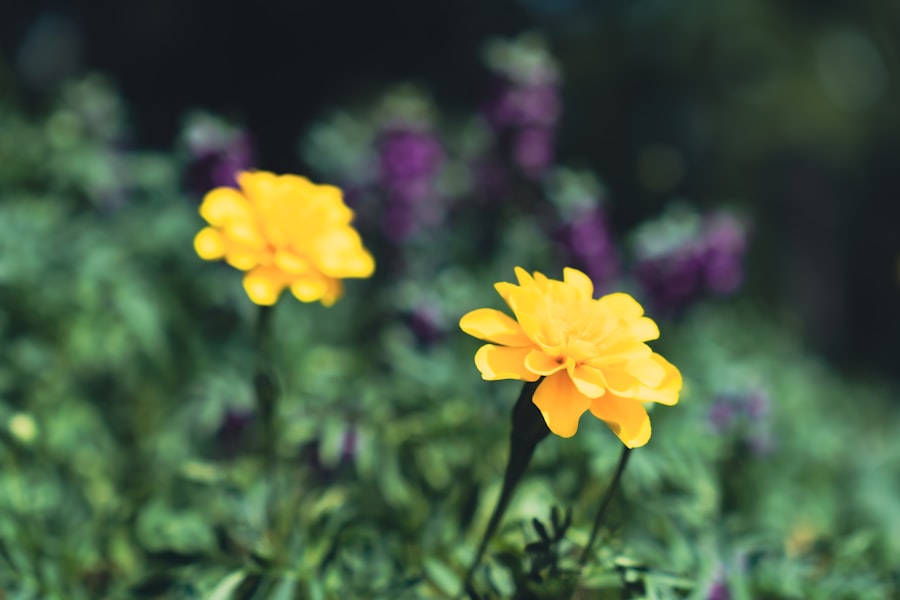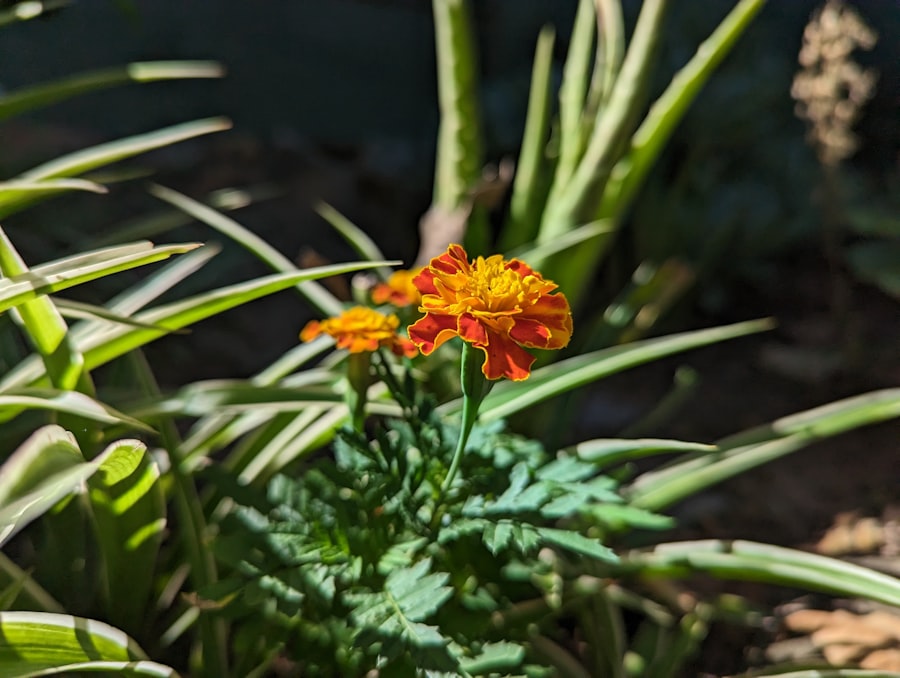The African Marigold, scientifically known as Tagetes erecta, is a vibrant and hardy flowering plant that has captured the hearts of gardeners and horticulturists around the globe. Renowned for its striking golden-yellow blooms, this species of marigold is not only visually appealing but also possesses a range of beneficial properties that make it a popular choice in gardens, landscapes, and even agricultural settings. The plant’s robust nature allows it to thrive in various climates, making it a versatile addition to any garden.
Its ability to attract pollinators while repelling certain pests further enhances its appeal, establishing it as a staple in both ornamental and functional gardening. The African Marigold is characterized by its tall stature, often reaching heights of up to three feet, with large, pom-pom-like flowers that can measure several inches across. These blooms are typically a rich shade of yellow or orange, creating a stunning contrast against the deep green foliage.
Beyond its aesthetic qualities, Tagetes erecta is also celebrated for its medicinal properties and cultural significance in various societies. As we delve deeper into the history, characteristics, cultivation practices, and uses of this remarkable plant, we will uncover the multifaceted role that African Marigold plays in our lives.
Key Takeaways
- African Marigold Tagetes Erecta is a vibrant and popular flowering plant known for its bright and colorful blooms.
- The African Marigold Tagetes Erecta has a rich history and origin, with roots in Mexico and Central America.
- This plant comes in various sizes and colors, with some popular varieties including the ‘Crackerjack’ and ‘Disco’ series.
- Cultivating and caring for African Marigold Tagetes Erecta involves providing well-drained soil, full sun, and regular watering.
- African Marigold Tagetes Erecta is not only a beautiful addition to gardens but also has medicinal properties and is used in traditional cultural practices.
History and Origin of African Marigold Tagetes Erecta
From the Americas to Europe and Beyond
Over time, the marigold made its way to Europe and Africa through trade routes and exploration, where it was embraced for its vibrant colors and resilience.
A Cultural Icon in Africa
The name “Tagetes” is derived from the Etruscan deity Tages, who was associated with agriculture and fertility, reflecting the plant’s agricultural significance. In Africa, Tagetes erecta has become deeply embedded in cultural practices and traditions. It is often used in ceremonies and festivals, symbolizing life and renewal.
Adaptability and Cultural Significance
The plant’s introduction to various regions has led to the development of numerous local varieties, each adapted to specific climates and soil conditions. This adaptability has allowed African Marigold to flourish in diverse environments, from the arid landscapes of North Africa to the lush gardens of sub-Saharan regions. The historical journey of this plant illustrates not only its botanical resilience but also its cultural importance across different societies.
Characteristics and Varieties of African Marigold Tagetes Erecta

Tagetes erecta is distinguished by its robust growth habit and striking floral display. The plant typically features upright stems that can grow between 24 to 36 inches tall, adorned with large, densely packed flower heads that can range from 2 to 5 inches in diameter. The flowers are composed of numerous petals that create a ruffled appearance, often exhibiting shades of yellow, orange, or even cream.
The foliage is dark green and feathery, providing an attractive backdrop that enhances the visual impact of the blooms. There are several notable varieties of African Marigold, each with unique characteristics that cater to different gardening preferences. One popular variety is the ‘African Orange,’ known for its vibrant orange flowers that stand out in any garden setting.
Another well-regarded cultivar is ‘Inca Gold,’ which features a rich golden hue and is particularly favored for its long-lasting blooms. Additionally, ‘Crackerjack’ marigolds are known for their large flower heads and bushy growth habit, making them ideal for creating bold garden displays. These varieties not only differ in color but also in growth habits and resilience to environmental stressors, allowing gardeners to select the best options for their specific needs.
Cultivation and Care of African Marigold Tagetes Erecta
| Aspect | Information |
|---|---|
| Planting | Plant in well-drained soil with full sun exposure |
| Watering | Water regularly, allowing the soil to dry between waterings |
| Pruning | Pinch off dead flowers to encourage new growth |
| Fertilizing | Use a balanced fertilizer every 4-6 weeks |
| Pests | Watch for aphids and spider mites, treat with insecticidal soap if necessary |
Cultivating African Marigold requires attention to several key factors that contribute to its successful growth. This plant thrives in full sun conditions, requiring at least six hours of direct sunlight each day to produce abundant blooms. It prefers well-drained soil enriched with organic matter, which helps retain moisture while preventing root rot.
Before planting, it is advisable to amend the soil with compost or well-rotted manure to enhance fertility and improve drainage. Watering practices are crucial for the health of Tagetes erecta. While the plant is relatively drought-tolerant once established, consistent moisture is essential during its early growth stages.
Gardeners should aim to keep the soil evenly moist but not waterlogged. Fertilization can further boost growth; a balanced fertilizer applied every four to six weeks during the growing season can promote lush foliage and prolific flowering. Regular deadheading—removing spent blooms—encourages continuous flowering throughout the season, ensuring that the garden remains vibrant and colorful.
Uses and Benefits of African Marigold Tagetes Erecta
The uses of African Marigold extend far beyond mere ornamental appeal; this plant offers a plethora of benefits that make it a valuable addition to gardens and agricultural practices alike. One of its most notable advantages is its ability to attract beneficial insects such as bees and butterflies, which play a crucial role in pollination. This characteristic makes Tagetes erecta an excellent companion plant in vegetable gardens, where it can help increase yields by enhancing pollinator activity.
In addition to its role in attracting pollinators, African Marigold is also known for its pest-repelling properties. The strong scent emitted by the foliage can deter nematodes and other harmful insects, making it an effective natural pest control option. This quality has led to its use in organic farming practices as a companion plant alongside crops like tomatoes and peppers.
Furthermore, extracts from marigolds have been studied for their potential medicinal properties, including anti-inflammatory and antimicrobial effects, adding another layer of utility to this remarkable plant.
Symbolism and Cultural Significance of African Marigold Tagetes Erecta

The cultural significance of African Marigold is deeply rooted in various traditions around the world. In many African cultures, marigolds are associated with celebrations and rituals that honor life and death. For instance, during certain festivals, marigolds are used to create vibrant floral arrangements that adorn altars and homes, symbolizing the connection between the living and the spiritual realm.
Their bright colors are often seen as representations of joy and vitality, making them a popular choice for festive occasions. In addition to their role in celebrations, marigolds hold symbolic meanings in other cultures as well. In Mexico, marigolds are integral to the Day of the Dead (Día de los Muertos) celebrations, where they are used to create altars honoring deceased loved ones.
This cultural significance highlights how Tagetes erecta transcends mere aesthetics; it embodies deep-rooted beliefs about life, death, and remembrance across different societies.
Pests and Diseases that Affect African Marigold Tagetes Erecta
Despite its hardiness, African Marigold is not immune to pests and diseases that can threaten its health and vitality. Common pests include aphids, spider mites, and whiteflies, which can infest the foliage and sap nutrients from the plant. Aphids are particularly notorious for their rapid reproduction rates; they can quickly overwhelm a marigold plant if not managed promptly.
Regular monitoring and introducing natural predators like ladybugs can help keep these pests at bay. In terms of diseases, Tagetes erecta may be susceptible to fungal infections such as powdery mildew or root rot if conditions are overly damp or if air circulation is poor. Powdery mildew manifests as a white powdery coating on leaves and can hinder photosynthesis if left untreated.
To prevent such diseases, it is essential to ensure proper spacing between plants for adequate airflow and to avoid overhead watering that can create a humid environment conducive to fungal growth. Implementing crop rotation practices can also minimize disease incidence by disrupting pest life cycles.
Celebrating the Vibrant Beauty of African Marigold Tagetes Erecta
The African Marigold Tagetes erecta stands as a testament to nature’s beauty and resilience. Its vibrant blooms not only enhance gardens but also serve practical purposes in agriculture and cultural practices worldwide. From its rich history rooted in ancient civilizations to its modern-day applications in pest management and ornamental gardening, this remarkable plant continues to thrive across diverse landscapes.
Whether adorning a garden bed or gracing a ceremonial altar, Tagetes erecta remains a symbol of vibrancy and life that resonates with people across generations and cultures.

